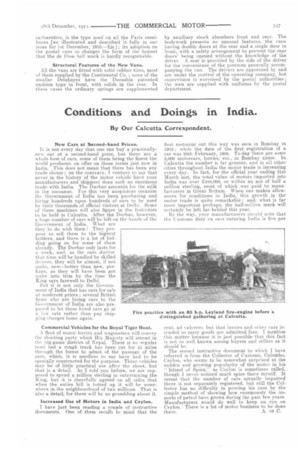Conditions and Doings in India.
Page 7

If you've noticed an error in this article please click here to report it so we can fix it.
By Our Calcutta Correspondent.
New Cars at Second-hand Prices.
It is not every day that, one can buy a practicallynew car at a second-hand price, but there are a whole host of cars, some of them being the finest the world produces, on offer on those terms just now in India. This does not mean that there has been any trade slump ; on the contrary, I venture to say that never in the history of the motor vehicle have your manufacturers and shippers done such an enormous trade with India. The Durbar accounts for the milk in the cocoanut. For this very auspicious occasion the Government of India has been purchasing and hiring hundreds upon hundreds of cars to be used by their thousands of official visitors at Delhi. Some of these machines will also figure in the festivities to be held in Calcutta. After the Durbar, however, a huge number of cars will be left on the hands of the Government of India. What are
they to do with them l They pro pose to sell them to the highest bidders, and there is a lot of bidding going on for some of them already. The Durbar only lasts for a week, and, as the ears during that time will be handled by skilled drivers, they will be almost, if not quite, new—better than new, perhaps, as they will have been got quite into trim by the time the King says farewell to Delhi.
But it is not only the Government of India that has cars for sale at moderate prices ; several British firms who are hiring cars to the Government of India are also prepared to let these hired ears go at a. low rate rather than pay shipping charges home again.
Commercial Vehicles for the Royal Tiger Hunt.
A fleet of motor lorries and wagonettes will convey the shooting party which His Majesty will attend in the big-game district of ,Nepal. There is no regular road but a rough track has been cut for 45 miles through the forest to admit of the passage of the cars, which, it is needless to say have had to be specially constructed for the purpose. These vehicles may be of little practical use after the shoot, but that is a detail. As I told you before, we are supposed to spend a million sterling in entertaining the King, but it is cheerfully agreed on all sides that when the entire bill is totted up it will be somewhere in the neighbourhood of two millions. That is also a detail, for there will be no grumbling about it.
Increased Use of Motors in India and Ceylon.
I have just been reading a couple of instructive documents. One of them recalls to mind that the
first motorcar out this way was seen in Bombay in 1902 ; while the date of the first registration of a car was 20th February, 1905. To-day there are some 2,000 motorcars, lorries, etc., in Bombay alone. In Calcutta the number is far greater, and in all other cities throughout India the motor trade is increasing every day. In fact, for the official year ending 31st March last, the total value of motors imported into India was over 2488,000, or within an ace of half a million sterling, most of which was paid to manufacturers in Great Britain, When one makes allowances for conditions in India, this growth in the motor trade is quite remarkable ; and, what is far more important perhaps, the half-million mark will certainly be left far behind this year.
By the way, your manufacturers should note that the Customs duty on ca rs entering India is five per cent. ad valorem, but that lorries and other cars intended to carry goods are admitted free. I mention this matter because it is just possible that this fact is not so well known among buyers and sellers as it should be.
The second instructive document to which I have referred is from the Collector of Customs, Colombo, Ceylon, who seems to be somewhat surprised at the sudden and growing popularity of the motor in his "Island of Spice," as Ceylon is sometimes called, though I never noticed much spice there myself. It seems that the number of cars actually imported there is not separately registered, hut still the Collector has no difficulty in proving his case by the simple method of showing how enormously the imports of petrol have grown during the past few years. 'Manufacturers would do well to keep an eye on Ceylon. There is a lot of motor business to be done there. A. or C.




















